#also a theme of textile printing
Text
if you could pick the met gala theme what would you choose??
#i heard a rumor a while back that a theme would be athletic fasion innovation and i LOVED that idea#also a theme of textile printing#like. dif types of printing techniques/patterns/customs....#printing has been around for over 2k years there is SO MUCH.#anyways rb this i want to see what other ppl want#oh also maybe smth abt silhouette???
14K notes
·
View notes
Text

Meet the Artist: @sakrafka
Hello, I’m Boka or Farkas (Far-kash)!
I’m an Eastern European artist under the name of sakrafka (shak-raf-ka). The themes of my art mainly revolve around sapphic and transmasc identities, wlw, nature, animals, and creatures (dragons!!!). I love experimenting and working with different mediums, mainly sculpting with ceramic and polymer clay but I also make animations, linocuts, textile printing, and more. One of the core elements of my work is to create more representation for gender-nonconforming people, especially women - because as such, I’ve always felt very isolated in my identity. I love breaking gender stereotypes and creating a space for people where they can recognize themselves in my work which I never had growing up. If you are autistic, queer or just love creatures, I hope you’ll enjoy my work!
Nice to meet you, Farkas! Below are some pieces she has picked out for you all.

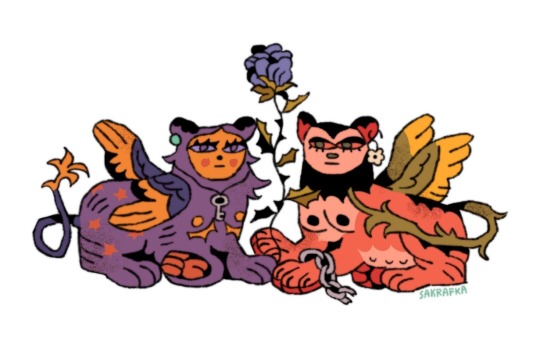

Check out more of Farkas’ work, and be sure to check out their Tumblr, @sakrafka!
-
We are highlighting some of Tumblr’s talented LGBTQIA+ artists all month as part of #june on tumblr! Be sure to check out @prideplus for more.
#meet the artist#meet the artist on tumblr#artists on tumblr#art#lesbian pride#june on tumblr#lgbtqia+ on tumblr
6K notes
·
View notes
Text
Translation thoughts on the greatest poem of our time, “His wife has filled his house with chintz. To keep it real I fuck him on the floor”
It’s actually quite tricky to translate. Because it’s so short, each word and grammatical construction is carrying a lot of weight. It also, as people have noted, plays with registers. “Chintz” is a word with its own set of associations. Chintz is a type of fabric with its origins in India. The disparaging connotation is from chintz’s eventual commonality. Chintz was actually banned from England and France because the local textile mills couldn’t compete.
Keep it real” is tremendously difficult to translate -- it’s a bit difficult to even define. It means to be authentic and genuine, but it also has connotations of staying true to one’s roots. Like many English slang words, it comes first from AAVE. From this article on the phrase:
“[K]eeping it real meant performing an individual’s experience of being Black in the United States. As such, it became a form of resistance. Insisting on a different reality, one that wasn’t recognized by the dominant culture, empowered Black people to ‘forge a parallel system of meaning,’ according to cultural critic Mich Nyawalo...The phrase’s roots in racialized resistance, however, were erased when it was adopted by the mostly-White film world of the 1970s and ’80s....Keeping it real in this context indicated a performance done so well that audiences could forget it was a performance.This version of keeping it real wasn’t about testifying to personal experience; it was about inventing it.”
One has to imagine that jjbang8 did not have the origins of these phrases in mind when composing the poem, but even if by coincidence, the etymological and cultural journeys of these two central lexemes perfectly reflect the themes of the poem. The two words have themselves traveled away from the authenticity they once represented, and, in a new context, have taken on new meanings -- the hero of our poem, the unnamed “him”, is, presumably, in quite a similar situation.
Setting aside the question of register, of the phonology, prosody, and meter of the original, of the information that is transmitted through bits of grammar that don’t necessarily exist in other languages -- a gifted translator might be able to account for all of these -- how do you translate the journey of the words themselves?
In my translations, I decided to go for the most evocative words, even if they don’t evoke the exact same things as in the original. The strength of these two lines is that they imply that there’s more than just what you see, whether that’s the details of the story -- what’s happening in the marriage? how do the narrator and the husband know each other? -- or the cultural background of the very words themselves. I wanted to try and replicate this effect.
Yiddish first:
זייַן ווייַב האָט אָנגעפֿילט זייַן הויז מיט הבלים
צו בלייַבן וויטיש, איך שטוף אים אופֿן דיל.
zayn vayb hot ongefilt zayn hoyz mit havolim.
tsu blaybn vitish, ikh shtup im afn dil
This translation is pretty direct. There is a word for chintz in Yiddish -- tsits -- but, as far as I can tell, it refers only to the fabric; it doesn’t have the same derogatory connotation as in English. I chose, instead, havolim, a loshn-koydesh word that means “vanity, nothingness, nonsense, trifles”. In Hebrew, it can also mean breath or vapor. I chose this over the other competitors because it, too, is a word with a journey and with a secondary meaning. Rather than imagining the bright prints of chintz, we might imagine a more olfactory implication -- his wife has filled his house with perfumes or cleaning fluids. It can carry the implication that something is being masked as well as the associations with vanity and gaudiness.
Vitish -- Okay, this is a good one. Keep in mind, of course, that I’ve never heard or seen it used before today, so my understanding of its nuances is very limited, but I’ll explain to you exactly how I am sourcing its meaning. The Comprehensive Yiddish-English Dictionary (CYED) gives this as “gone astray (esp. woman); slang correct, honest”. I used the Yiddish Book Center’s optical character recognition software, which allows you to search for strings in their corpus, to confirm that both usages are, in fact, attested. It’s a pretty rare word in text, though, as the CYED implies, it might have been more common in spoken speech. It appears in a glossary in “Bay unds yuden” (Among Us Jews) as a thieves cant word, where it’s definted as נאַריש, שרעקעוודיק, אונבעהאלפ. אויך נישט גנביש. אין דער דייַטשער גאַונער-שפראַך -- witsch -- נאַריש, or “foolish, terrible, clumsy/pathetic. not of the thieves world. in the German thieves cant witsch means foolish”. A vitishe nekeyve (vitishe woman) is either a slacker or a prostitute. I can’t prove this for sure, but my sense is that it might come from the same root as vitz, joke (it’s used a couple of times in the corpus to mention laughing at a vitish remark -- which makes it seem kind of similar to witty). I assume the German thieve’s cant that’s being referred to is Rotwelsch, which has its own fascinating history and, in fact, incorporates a lot of Yiddish. In fact, for this reason, some of the first Yiddish linguists were actually criminologists! What an excellent set of associations, no? It has the slangy sense of straightforward of honest; it has a sense of sexual non-normativity (we might use it to read into the relationship between the narrator and the husband) -- and a feminized one at that; it was used by an underground subculture, and, again, the meaning there was quite different -- like the “real” in “keeping it real” it was used to indicate whether or not someone was “in” on the life (tho “real” is used to mean that the person is in, while “vitish” is used to mean they’re not). It’s variety of meanings are more ambiguous than “keep it real”, which can pretty much only be read positively, and it also brings in a tinge of criminality. Though it doesn’t have the same exact connotations as “keep it real”, I think it’s about as ideal of a fit as we’ll get because it’s equally evocative of more below the surface. I also chose “tsu blaybn vitish”, which is “to stay vitish”, as opposed to something like “to make it vitish” to keep the slight ambiguity of time that “keep it real” has -- keeping it real does< I think, imply that there is a pre-existing “real” to which one can adhere, so I wanted to imply the same.
The rest is straight-forward. “Shtup” is one of a few words the Comprehensive English-Yiddish Dictionary (CEYD) gives for “fuck”, and I think it has a nice sound.
Ok, now Russian
женой твой дом наполнен финтифлюшками
чтоб не блудить с пути, ебемся на полу
zhenoy tvoy dom napolnin fintiflyushkami.
shtob ne bludit’ s puti’, yebyomsya na polu
In order to preserve, more or less, the iambic meter, I made a few more changes here -- since Russian, unlike Yiddish, is not a Germanic language, it’s harder to keep the same structure + word order while also maintaining the rhythm. I would translate this back to English as:
“Your house is filled with trifles by your wife. To not stray off the path, we’re fucking on the floor”
So a few notes before we get into the choice of words for “chintz” and “keep it real”. To preserve the iamb, I changed “his” to “your”. This changes the lines from a narration of events to some outside party to a conversation between the two men at the center. Russian also has both formal and informal you (formal you is also the plural form, as is the case in a number of other languages). I went with informal you because I wanted to preserve the fact that his wife has filled his house not their house, as someone pointed out in the original chain (though I don’t think that differentiation is nearly as striking in the 2nd person) and because it’s unlikely you’d be on formal you with someone you’re fucking (unless it’s, like, a kink thing). I honestly didn’t even consider making it formal, but that would actually raise a lot of interesting implications about the relationship between the speaker and the husband, as well as with what that means about the “realness” of the situation. Is, in fact, the narrator only creating a mirage of a more real, more meaningful encounter, while the actual truth -- that there is a woman the husband has made promises to that he’s betraying -- is obscured? that this intimacy is just a facade? Is there perhaps some sort of power differential that the narrator wishes to point out? Or perhaps is the way that the narrator is keeping it real by pointing out the distance between the two of them? there is no pretense of intimacy, the narrator is calling this what it is -- an encounter without deeper significance?
Much to think about, but I actually think the two men do have history -- i think the narrator remembers the house back when it was actually only “his house” and was as yet unfilled with chintz. We also don’t know what they were calling each other prior to this moment. This could be the first time they switched to the informal you.
Ok moving on, I originally translated it as “твой дом наполнен финтифлюшками жены”. Honestly, this sounds more elegant than what I have now, but I ultimately though removing the wife from either a subject or agent position (grammatically, I mean) was too big a betrayal of the original. The original judges the wife. She took an active role in filling the house. If she were made passive, that read is certainly a possible one -- perhaps even the dominant one -- but it could also read more like “we are doing this in a space filled with reminders of his wife and the life they share” -- the action of filling is no longer what’s being focused on. Why do I say the current translation is inelegant? I feel you stumble over it a little, because it’s almost a garden path sentence. This is also an assset though. “Zhenoy tvoy dom napolnen” is a fully grammatical sentence on its own, and it means “Your house is filled by your wife” -- as in English, the primary read is that the wife is what the house is full of. If the sentence makes you stumble, perhaps that’s even good -- we focus, for good reason, on the relationship between the two men, but in a translation, the wife is able to draw more attention to herself.
Ok, chintz: I chose the word “финтифлюшки” (fintiflyushki), meaning trifle/bobble/tchotchke, because it, allegedly, comes from the german phrase finten und flausen, meaning illusions and vanity/nonsense. Once again, I like that the word has a journey, specifically a cross-linguistic one.
Keep it real: this one, frankly, fails to capture the impact of the original, in my opinion, but allow me to explain the reasoning. “Stray off the path” implies, again, that there is some sort of path that both the narrator and the husband were on before the wife and the chintz -- and one they intend to continue taking, one that this act is a maintenance of. It brings in a little irony, since the husband very much is straying from the path of his marriage. “Bludit’“ can also mean to be unfaithful in a marriage (as, in fact, can “stray”). The proto-slavic word it comes from can mean to delude or debauch -- they want to do the latter but not the former.
As for register -- “shtob” is a bit informal. I would write the full version (shto by) in an email, for example. The word for fuck, yebyomsa, is from one of the “mat” words, the extra special top tier of russian swears, definitely not to be said in polite company (and, if you are a man of a certain generation or background, not in front of women; it’s not that the use of mat automatically invokes a male-only environment, but if we’re already thinking that deeply about it. But while we’re on the topic, i will say that in my circles in the US, women use mat much more actively than men (at least in front of me, who was, up until recently, a woman and also a child).)
Ok i think that’s all the comments i have!
#can you imagine if someone called you вы during sex unironically#i'd be like 'ты че? лучше меня тыкай' haha do you guys get it#also if you have not checked out the YBC's OCR software DO IT
5K notes
·
View notes
Text
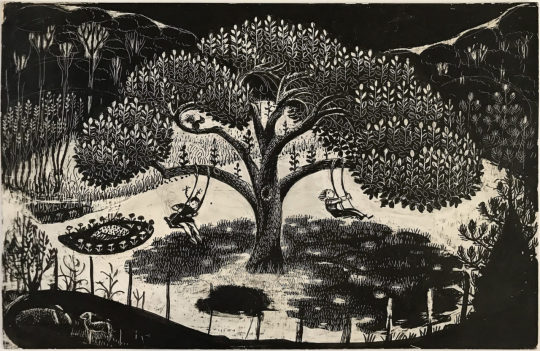

Virginia Lee Burton (1909-1968) was one of the most significant and groundbreaking children’s book author/illustrators of the 20th Century. Her classic books have never been out of print and are currently embraced by a fourth generation of early readers. This is an extraordinary achievement in the world of children’s picture books. The importance of early reading experiences to a child’s development is profound and Burton’s contribution to a child’s love of reading and ongoing literacy is significant.
Burton was at the forefront of the developing American Picture Book. Her dynamic illustrations, use of colour, space, typeface and design were a dramatic departure from the European picture books that were prevalent in the United States in the early 20th Century. Similarly, her themes of overcoming obstacles, meeting challenges, environmental awareness and adapting to change while honouring the past are evergreen and have a particularly American energy and spirit.
She also founded and led The Folly Cove Designers, a group of designer-craftsmen living on and around Cape Ann, north of Boston MA, which operated from the late 1930’s through the late 1960’s, and achieved international renown for the excellence of its block-printed textiles and designs.
For more information about Virginia Lee Burton go to www.virginialeeburton.com
86 notes
·
View notes
Note
Is tumblr an ok-ish place to just like, info dump about my world and it’s lore, or is there a better place I could do it?
Tex: You can put anything on tumblr so long as you don’t violate the Terms of Service - I’ve seen moodboards, essays, sketches, stories, bullet point lists, gif sets, audio clip compilations, and pretty much anything that the various posting formats can support.
It’s not necessarily something like a catch-all or one-size-fits-all, but I think it helps to think of various websites as boxes with different utilities, much in the same theme as scrapbooking parts. For example, tumblr supports images well, Archive of Our Own (AO3) supports text well, and have the shared similarity of ability to tag posts or works for organizational purposes.
The internet is one, very useful, format to worldbuild, because it has the ability to utilize tools such as hyperlinking and digital archiving. In a previous post, there is a detail about how to organize a digital file structure for one’s worldbuilding to keep track of things, available here. One practice I have noticed among some worldbuilders is the blend of digital and physical spaces; or rather, online and offline.
Offline digital worldbuilding is such things as word documents, saved images, and programs that perform the function of notebooks that don’t require internet access and/or an internet browser. This is frequently supplemented by personal archiving habits, such as a dedicated peripheral drive like a USB, and regularly copying over digital files onto that device whenever significant changes are made or else on a schedule. This is useful for happenstance events like computer failure, websites going defunct, or related issues.
Offline physical worldbuilding is such things as notebooks, drawings or paintings, boxes of ephemera, scrapbooks, and physical copies of the canon media (if the worldbuilding has its roots in fandom). This can include CDs, DVDs, photos, and craft items such as textiles or sculptures. For people that have had difficulties in maintaining digital records in particular, physical copies are often a good method of maintaining linearity of thought - i.e. printing out a Google Doc and putting that into a folder.
Because there’s so many different medias and platforms you can use for worldbuilding, it’s more a matter of which suits you best and for which purpose. Tumblr is a useful component of a worldbuilding methodology portfolio because of its capability to create dedicated posts that can be mixed media, tagged, and archived if one wishes it. As of this time of posting, users cannot currently download an individual post, but it’s impossible to predict a website’s roadmap as it adapts to the changing needs of digital spaces.
One thing I would note is that tumblr need not be engagement driven, in the same way other online spaces tend to be (e.g. twitter). You can make a blog, add restrictions in the form of locking viewing to only logged-in users or adding a password to view the blog, and with the recent update (as of this posting), users can also toggle preferences on how public a post is and also ability for others to reblog a post.
If you’re looking for engagement, this is fuelled by reblogs, which generally depends on the blogs that you follow and interact with, usually by reblogging their posts and also by talking to them. That is, however, a subject of micro-cultures and subcultures therein, which becomes a little bit off-subject to your question and not really within our domain.
29 notes
·
View notes
Text

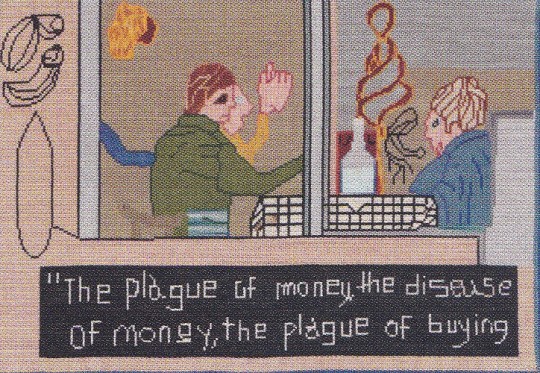

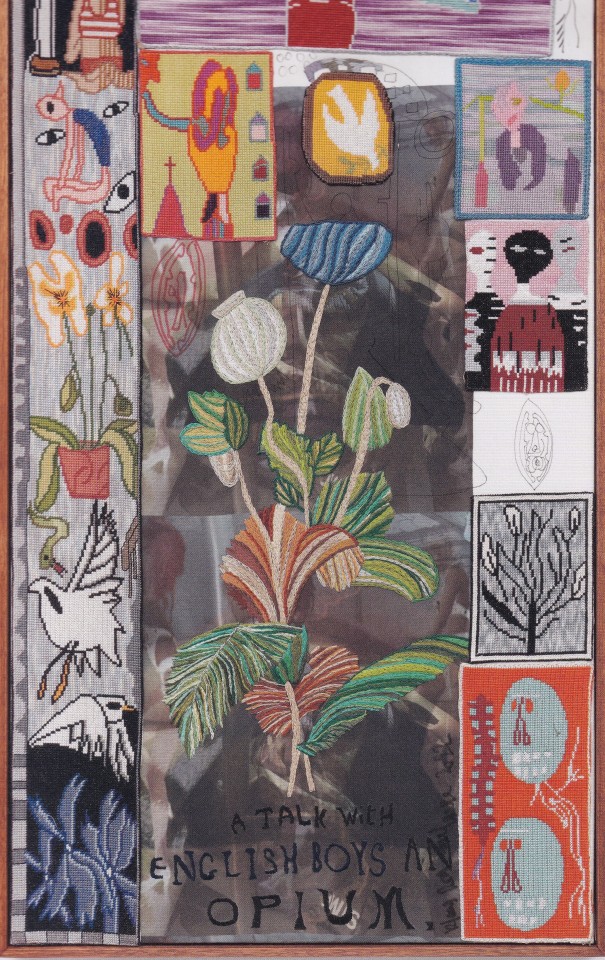
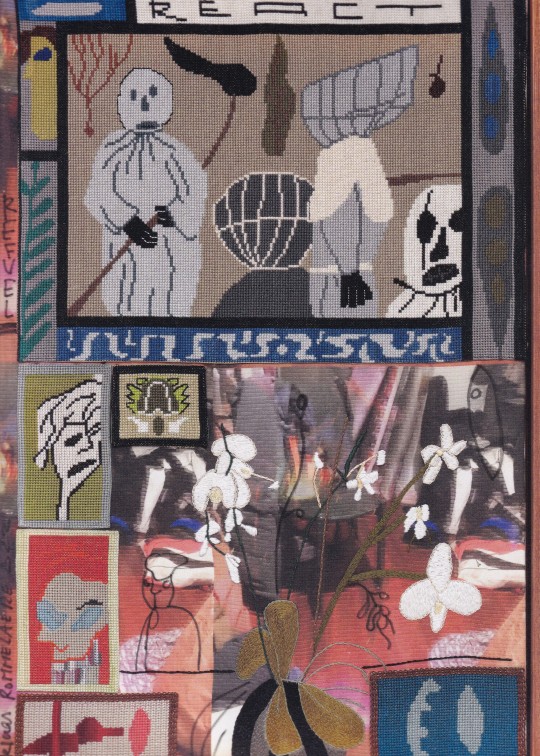



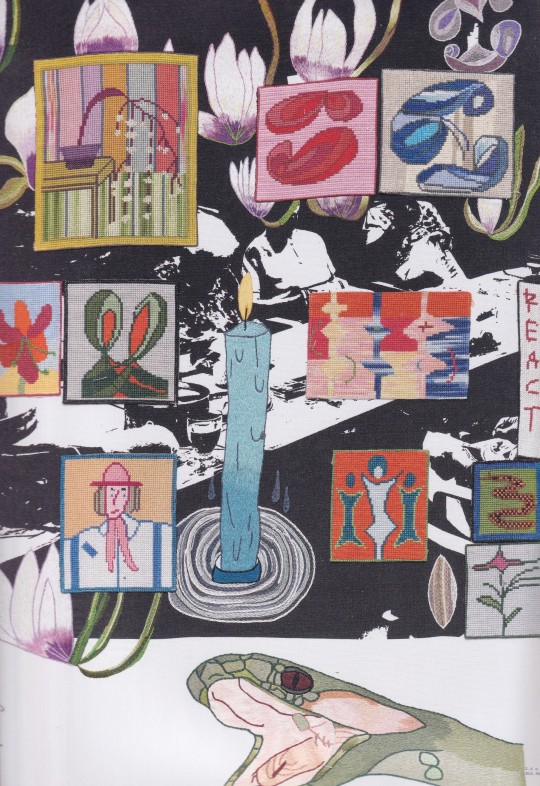

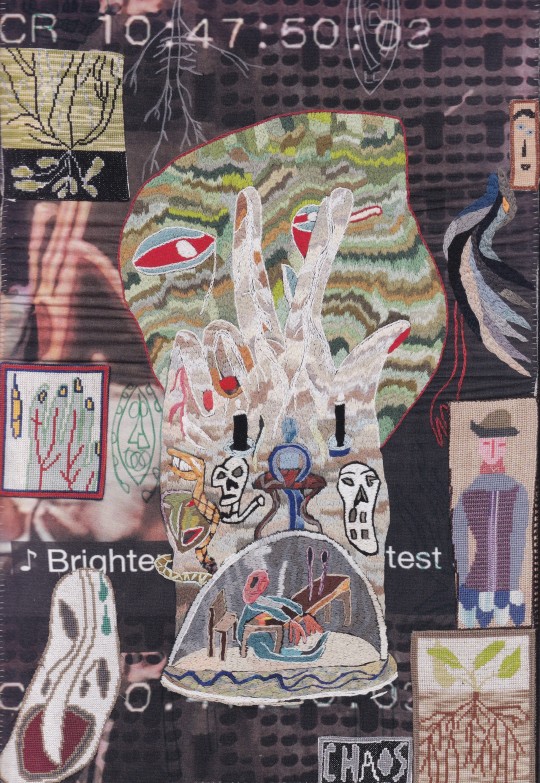
Klaas Rommelaere Johnny
design and editing: Jurgen Maelfeyt
Art Paper Edition, November 2023, 40 + 16 pages, 24x34cm, ISBN 9789464770841, edition of 500 copies
euro 35,00
email if you want to buy [email protected]
In 2021, Klaas Rommelaere saw Adam Curtis' documentary Can't Get You Out of My Head: An Emotional History of the Modern World. Using found footage, Curtis examines the power structures that shape our world. He touches on themes such as individualism versus collectivism, conspiracy theories, American imperialism, the history of China and artificial intelligence.
The nihilism Rommelaere felt reminded him of Mike Leigh's award-winning 1993 film Naked, in which the intellectual but dominant and violent twenty-something Johnny wanders through gloomy post-Thatcherian London and shares his dark world view with anyone who will listen.
Rommelaere incorporates both “Can't Get You Out of My Head" and "Naked” in his new series Johnny, taking screen shots from both films and printing them on textile; one series on cotton and one on velour. In addition to the dark message of both films, Rommelaere also displays his personal images of doom. For example, he has a panicky fear of snakes - a symbol that recurs frequently in this series - and for a period he was afraid of buildings collapsing, a fear he retained from a trip to Tokyo, where earthquakes regularly occur.
Although he does not want to look away from the pain of the world, he instead places something in return: comfort and beauty. An image from a dance performance by Rosas, for example. Or nature in the form of the orchids in his studio. Yoga too. A focus on human anatomy, which stands for vitality. Rommelaere embroiders 'Chaos' on several of his new works, as well as 'react', 'reload', 'recharge'. And so the Johnny series becomes his highly personal attempt to create order out of chaos.
Exhibition at Madé van Krimpen + Booklaunch
04.11 — 16.12
Prinsengracht 615H Amsterdam
thu-sat 12:00-18:00
03/02/24
#Klaas Rommelaere#Johnny#art exhibition catalogue#Amsterdam 2023#500 copies edition#shots from films on textiles#fashionbooksmilano
4 notes
·
View notes
Photo

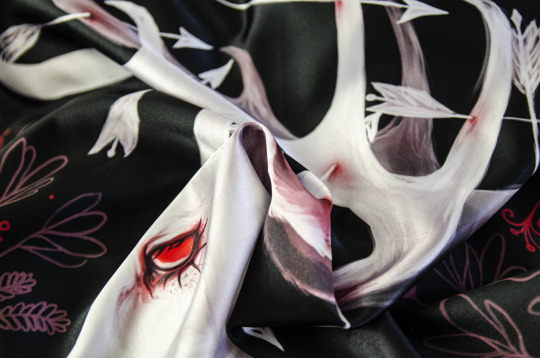

As you migh know... my favourite kind of print isn’t on paper, but on textile! I made very few of these scarves, as each are hand printed and sewn.
In many cultures, the "first hunt" has been an important ritual to perform in order to mark someones first step into adulthood. Hence, this artwork came to be for the folktaleweek prompt “ritual". 🦌 Hunting has been a historically neccessary activity for human survival, but there are countless of folktales and old stories that also touch on the subject of guilt. Often guilt from killing something as "pure" as an innocent animal. Because of how rare they are, white stags have often been portrayed as supernatural or mystical beings, as well as common symbols of purity and protectors of the forest. I thought I’d merge the themes in this artwork!
#scarf#scarfs#scarves#artwear#fashion design#textile printing#sublimation print#stag#deer#white stag#animal art#artists on tumblr#ritual#folklore#folktale#Julia Lundgren
32 notes
·
View notes
Text
✨ End of Year Questions ✨
Tagged by @ongreenergrasses 💖
I also didn’t think I created much this year, and. To be completely honest, I didn’t really make much new art, and what I did I didn’t really post here. Most of what I’ve done this year is really continue writing snippets of lyrics/verses/poetry in my notes. Hoping to make more time for a lot of things this year!
What is the favourite thing you created?
A sailboat reduction print (lino style but on a literal disposable plate)
Which work are you most proud of?
Honestly, either that same sailboat print or some of the poetry/lyric snippets I’ve written this year. Or the leather medicine pouch (also created for my class final project)
Is there anything you’re proud that you achieved this year?
I’m proud that I created anything at all outside of class requirements (I took one art centred course at the beginning of the year, which my sailboat print was created in)
Did you explore anything new this year?
Not so much for creating, but I did get stickers made of some of my previous work to sell at fairs and whatnot.
Wait no the leather medicine pouch - I haven’t done much leatherwork yet though I really want to create super long lasting functional pieces and textiles is very new to me and is a way of connecting to my grandmothers’ past. And I also joined a sewing/quilting club at school (which doesn’t seem to be running this year but I have no time anyway this semester so that’s fine) (I have not finished the sewing supply bag project we started)
Which work gave you the most difficulty?
Anything finished haha. I am still striving to fully finish and edit and refine some of my lyrics into songs (eventually to try to record and produce with whatever free and/or cheap software I can find).
Also some of the more unusual custom cake requests at work were difficult to do but they worked out.
And textiles can be. Frustrating.
What was your biggest creative challenge this year?
Finding time to create. I definitely took this as a year to go and do things that I. Had to go to. And while I probably could’ve brought a mini sketchbook with me, I didn’t usually.
Which work brought you the most joy?
A birthday card I did for a friend. It’s a pen sketch of their favourite beach (at least the view I got when I took a quick visit and picture of it)
Which of your works do you think people should check out?
…from 2023 nothing is posted unless you’re on my personal instagram or something. (Unless I did post my year of the water rabbit watercolour paintings? In which case - those.)
Otherwise my Creating Awl Together story/series (once I make time to create more for it 😅)
Do you have creative plans for the new year? Is there anything exciting that you’re working on?
Oh always 🥺💖✨
I accidentally made a new years resolution to record one of the songs I’ve written,, but also I want it to be. Better than the literal middle school vent lyrics I’ve written.. so we are. Trying to write some new stuff and upgrade to… mid twenties vent lyrics… (and some like!?! Joyful lyrics too?!?!) (I’m actually excited and terrified and don’t really play any instruments right now and what I played on flute isn’t really necessarily the vibe for what’s in my head?? But it could have a place so I’ll probably play again and if need be I could probably rent a tenor sax for a day or so.) so. Next up is learning (or throwing together) a bit of music production (I am currently gathering royalty free free samples from anywhere I find them more or less)
I really want to draw a lot more this year!!
And paint more again!!
And of some of these drawings I want to transfer them to be lino cut or dry point and do them as prints!!!
I have several quilts I want to make!! I’m going to start really small though to. Learn how to sew them haha 😅 But I hope my first quilt is a lovely sea turtle themed quilt for one of my best friends’ cat. Or a lap quilt for mum. I. Realistically I don’t think I’ll get to this before the end of the year.
I want to paint more ceramic pieces at the paint your own ceramics place (I have. Several pieces that I just need to finish painting)
More cards that I drew on~ I have a bit more energy than last year despite everything it seems right now so I am hoping I can continue to draw on cards for my friends 💖
This shall be the year I finish my dogs out doodle (barefoot ship life!!!)
Lastly, any words of wisdom or advice to share?
To myself: just try. Just try. Just do. It can be whatever. Just create something. Just create anything. Joy, catharsis, one single line. Anything you can.
Given how late I filled this out I’m not tagging anyone 😬
2 notes
·
View notes
Photo
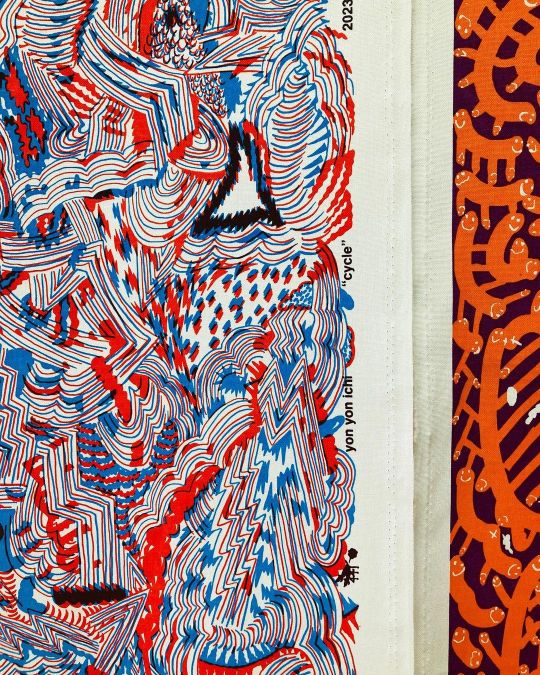
3/30木、本日18時まで営業。ヨンヨンイチの新作テキスタイル展示開催中です。展示もいよいよ今週末まで! 今日も作家の吉井が終日在廊いたします。 —- 441 yon yon ichi solo exhibition ‘Conversation Piece’ ヨンヨンイチ テキスタイル展 2023年3月11日(土)~4月2日(日) 木曜~日曜 12:00~18:00 月曜~水曜 休み 会場:WISH LESS gallery (東京都北区田端5-12-10) @yonyonichi441 @wish_less —- 441 yon yon ichiとは、吉井隆祐による自主制作のテキスタイルブランドです。鮮やかな色彩感覚とゆるやかな手描きのイラストを駆使し、常に新しいデザインを生み出しています。 布のプリント作業は職人によってシルクスクリーンで行われます。吉井が手作業にこだわるのは、機械では出せない微妙なズレや発色など、独特なコクと風合いを残したいからだと語ります。 本展では、「Conversation Piece」と「Cycle」と題したふたつのデザインテーマを、それぞれ異なる色彩でプリントした布をご紹介いたします。 タイトルと柄を見比べて、それぞれのテーマを自由に思い描いてみてください。 また会場では、新作テキスタイルプリントを用い、吉井自らハンドメイドで作ったプロダクトも展示・販売もいたします。 普段の生活の中で身近な存在である「布」も、見え方や感じ方の違いで空間を豊かに一新させる、テキスタイルの可能性をぜひ会場にて体感してください。 —- 441 yon yon ichi is an independently produced textile brand by Ryusuke Yoshii. Using a vivid sense of colour and loose hand-drawn illustrations, he is constantly creating new designs. The printing work on the cloth is produced using silkscreen by skilled craftsmen. Yoshii says he insists on handmade production because he wants to preserve the unique richness and texture of the fabric, including the subtle deviations and colouring that cannot be achieved by machine. This exhibition presents two design themes, ‘Conversation Piece’ and ‘Cycle’, printed on fabrics in different colours variations. Please compare the titles and patterns and try to imagine each theme freely. Also on display and for sale are bags and other small items handmade by Yoshii himself using the new textile prints. Come and experience the possibilities of modern textiles, which can enrich and renew a space with different ways of seeing and feeling the familiar “cloth” of everyday life. #yonyonichi #ヨンヨンイチ #テキスタイル #handmade #japaneseartist #wishless #wishlessgallery #art #tokyo #gallery #textile #textiledesign #fabric #布 #ファブリック #design #graphicdesign #colorful #pop #fashion #conversationpiece #カンバセイションピース (WISH LESS) https://www.instagram.com/p/CqZjJvXvHRF/?igshid=NGJjMDIxMWI=
#yonyonichi#ヨンヨンイチ#テキスタイル#handmade#japaneseartist#wishless#wishlessgallery#art#tokyo#gallery#textile#textiledesign#fabric#布#ファブリック#design#graphicdesign#colorful#pop#fashion#conversationpiece#カンバセイションピース
10 notes
·
View notes
Text


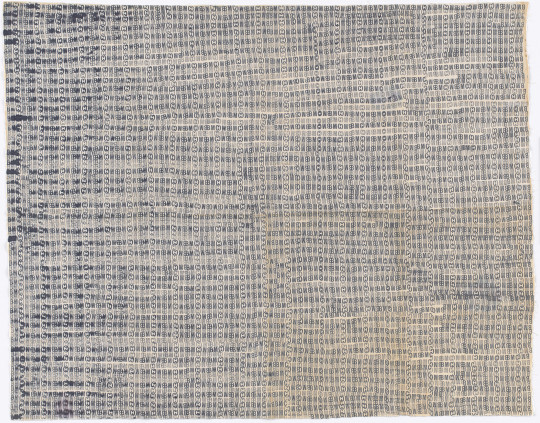
This week's theme is repeating elements: images containing identical or similar visual units stamped, pasted, drawn, or painted at regular intervals across the surface of a support. Variations in the color or placement of these units can lend a great deal of visual interest in what might otherwise read as boring wallpaper patterning.
In the Malian mud cloth at top, the same elements continually shift out of alignment with one another, defeating our expectation of symmetry and producing an endlessly fascinating pattern. Anna Albers challenged her textile students to create "woven" patterns using a typewriter; in this example, I find visual appeal in the contrast between the two very rigid patterns, as well as in the slight inconsistency of individual key strikes. Ruth Asawa used a laundry stamp reading "BMC" (for Black Mountain College in North Carolina, where she was a student and also the supervisor of the student-run laundry facility) to produce a dense overall pattern where every inconsistency adds to our perception of a wavy, undulating surface.
Bamana peoples, Mali, Africa. Bogolan Wrap, made before 1910. Cotton and dye, 54 1/2 x 34 1/16 inches. Metropolitan Museum of Art, New York.
Anni Albers (American, born Germany, 1899-1994). Studies made on the typewriter, not dated. Typewriter printing in blue ink on paper mounted on board, 10 1/2 x 6 1/2 inches. The Josef and Anne Albers Foundation, Bethany, CT. Source.
Ruth Asawa (American 1926-2013). Untitled (BMC.145, BMC Laundry Stamp) c. 1948-49. Stamped ink on fabric sheeting, 36 3/4 x 45 1/2 inches. Museum of Modern Art, New York.
1 note
·
View note
Text
Project statement for 'MOVEMENT'
3rd/March/2023

My project began as a visual investigation into the Gothic Architectural and Literature movement. I began my primary research by looking at the ornamentation and structures of Gothic Churches and Stained-glass windows. I was interested in this theme as I am fascinated by the towering arches and decoration, and I am also a big fan of harry Clarke's work. This then led me to studying forms and people in a stylized way.
I began with gesture drawings and then experimented with drawing on acetate to recreate the stained-glass window effect. I then continued this experiment into print through creating Lino stamps inspired by photos I had taken of Cathédrale Notre Dame de Strasbourg and printing onto acetate.
Along with gothic architecture I studied Gothic Literature and illustrations. I enjoy and collect gothic poetry and literature and so took scans from my own book pages and sewed, tore, and applied them to show the decay and macabre of the genre of writing. I then created a Screenprint based on ‘The Raven’ by Edgar Allen Poe.
I then approached the fashion module by basing my pieces on architectural features and fragmented forms. This led to my crochet piece, where I employed the technique of free form crochet. My crochet piece then inspired me to return to printing onto acetate. I took fragments of my crochet and created ‘panels’ and then cut out a stencil. I continued this combining of textiles and print by printing my Lino pieces onto fabric
Overall, I am not incredibly happy with the work I produced this semester and felt I could have pushed myself more and to be more experimentative. However, I enjoyed being in the studios of my chosen electives (painting, print & fashion), and this gave me focus and enthusiasm towards them.
9 notes
·
View notes
Text

Fashion Elective
Design workshop .
This morning we enlarged previous work we had and worked with croquis to make interesting designs . I chose previous markmaking I made in cereamics and painting and also painted fabric and enlarged areas I found interesting to do with my theme of childhood and spinning .


I feel these worked well and I plan on taking 20 of these designs and working with them to make different variations which will hopefully lead to a piece in fabric . I also want to incorporate fabric I had previously printed on .

I went back and got my textile swatches I made yesterday and layered them with the printouts of the markmaking and I think they make interesting designs . The spinning , rotating motion comes across well.
8 notes
·
View notes
Text
Fancy Home Decor Items in the United States by Amazon
Discover a wide range of fancy home decor items in the United States. Elevate your home's aesthetics with exquisite furnishings, elegant accents, and stylish accessories. Explore our curated collection of upscale home decor for timeless beauty and sophistication. Transform your abode into a haven of grandeur with our luxurious selection.

What is Fancy Home decor?
Are you seeking to add a touch of elegance and luxury to your living space? Fancy home decor may be just what you're looking for. In this guide, we'll explore the concept of fancy home decor and provide insights into how it can transform your interiors into
Sophisticated havens. From exquisite furniture to opulent accessories, discover the essence of fancy home decor and how it can elevate your living environment.
Fancy home decor offers a pathway to create elegant and luxurious living spaces. By incorporating high-quality furniture, statement lighting fixtures, opulent textiles, captivating artwork, and rich colors, you can transform your home into a haven of refined beauty. Understanding the key elements of fancy home decor and creating a coordinated look will help you achieve a stylish and sophisticated ambiance that reflects your personal style. Embrace the world of fancy home decor and elevate your interiors to new levels of grandeur and elegance.
Introduction
When it comes to creating a stylish and sophisticated living space, the right home decor items can make all the difference. In the United States, there is a wide range of fancy home decor items available to transform your house into a luxurious haven. From elegant furniture pieces to exquisite accents, this article will guide you through some of the most sought-after fancy home decor items in the United States that can elevate your living space to new heights.
Statement Lighting Fixtures
Lighting plays a crucial role in setting the ambiance of a room, and fancy lighting fixtures can instantly enhance the aesthetic appeal of your home. In the United States, you can find an array of statement lighting options, including chandeliers, pendant lights, and wall sconces. Opt for unique and eye-catching designs that not only illuminate your space, but also serve as a focal point, adding a touch of elegance to any room.
Luxurious Furniture
To create a truly fancy and inviting home, investing in luxury furniture is essential. The United States offers a vast selection of high-quality furniture pieces that exude opulence and style. From plush velvet sofas and intricately designed coffee tables to ornate bed frames and exquisite dining sets, there is something to suit every taste and interior design theme. Incorporate pieces made from premium materials like leather, silk, or polished wood to add a touch of sophistication to your living spaces.
Artwork and Wall Decor
Artwork and wall decor are vital elements that can transform a plain wall into a captivating visual display. In the United States, you can find a plethora of options to choose from, including paintings, sculptures, framed prints, and tapestries. Select pieces that resonate with your personal style and complement the overall aesthetic of your home. Hanging artwork strategically and using ornate mirrors as decorative accents can create an illusion of spaciousness and add a touch of glamour to your interiors.
Designer Rugs and Carpets
Luxurious rugs and carpets not only provide comfort underfoot, but also contribute to the overall ambiance of a room. The United States boasts a diverse range of designer rugs crafted from premium materials like silk, wool, or natural fibers. Consider selecting rugs with intricate patterns, vibrant colors, or unique textures to make a bold statement in your living spaces. Whether you opt for a Persian rug, a modern geometric design, or a vintage kilim, a well-chosen rug can tie together all the elements of a room and add a touch of lavishness.
Opulent Home Accessories
To complete the fancy look of your home, accessorizing with opulent items is essential. Look for decorative pieces such as crystal vases, silver candleholders, gilded photo frames, and intricate tableware. Incorporate luxurious textiles like silk or velvet for your curtains, cushions, and throws. These small but significant details can elevate the overall aesthetic of your space and create a sense of luxury and refinement.



#homedecor#home decoartion#home décor#beauty#yourbestly#home improvement#Fancy home decor items#fancy home decor#Fancy home decor items by Amazon
2 notes
·
View notes
Text
tag game
thanks @tomvorikandharry for tagging me <3
nickname: human google. beans.
height: 5’6” or 167.6 cm
last thing i googled: Александр Кутиков живет в Израиле сейчас? (i’m going to see Машина Времени in a few months, but i was curious to know if Kutikov had gotten duel citizenship like Makarevich).
song stuck in my head: keep it down by jack bruce (i bought a friend’s dad one of his solo vinyls for christmas, in addition to some lester young and paul desmond, but it started me back on a kick of listening to him).
amount of sleep: 6 hours. normal for me is 4-5.
dream job: when i finish my doctorate, i’ll be qualified to be a professor, or at least start on that track, and my advisor(s) and program have a great record of getting people into prestigious post-docs and tenure track positions. i may transition to another sector and work in a think tank/banking/foreign policy or diplomacy/etc. we’ll see how sick of academia i am 6 years from now.
wearing: blue jeans i bought from a little shop in soho a few years ago. grey mock neck and black blazer that i got vintage shopping in NYC last winter. lace up black combat-ish boots from Dune.
book/movie that summarizes me: weirdly enough, master and commander by patrick o’brian. not that i especially love that book, it’s definitely not my usual thing to read, but because of the character of queeney. as jack aubrey says of her:
“’Conic sections and the Pentateuch came as easy as kiss my hand to her. Dear Queeney. I thought she was to be an old maid, though she was so pretty; for how could any man make up to a girl that knows Hebrew? It seemed a sad pity: anyone so sweet-tempered should have a prodigious great family of children. But, however, here she is married to the admiral, so it all ends happy ... yet, you know, he is amazingly ancient — grey-haired, rising sixty, I dare say.’”
(every bit of that is scarily accurate, down to the hebrew (though mine is modern) and the maths).
current favorite song: is this what you wanted by leonard cohen (1974)
aesthetic: i feel like i’m aesthetically a bit of a chameleon, in that my space is decorated in a way which totally reflects my personality and interests while the way i dress is often more conservative and toned down, though it still contains elements of my fundamental style and often depends on the occasion. (for example when i was in london last week a friend kindly took me out to a very expensive jazz club and i wore a vintage black mini dress which had lace sleeves and a lace collar and a plunging lace only back cut-out with chunky tall michael kors velvet heels i bought second hand and black nylons. not at all what i would wear day to day but reflective of how and who i wanted to be in that environment). anyway, my flat is very ‘modern day scholar inhabits 16th century persianite harem.’ all jewel tones, intricate dark wood dividers, miniatures with inscriptions from rumi, patterned textiles, etc. but also loads of books, weird little presents friends have bought me, an egon schiele print, a random fortnum and mason’s basket, a kitchen fully stocked with east asian ingredients, etc.
fav author(s): this is a cruel question, but i’ll just pick a handful in no particular order. vladimir nabokov, joseph brodsky, saul bellow, evelyn waugh, jeet thayil, ma jian, salman rushdie, tom wolfe, t.s. eliot, sergei dovlatov, hayim nachman bialik, tomas transtromer, walker percy, milan kundera, italo calvino, hillel halkin, philip larkin, and so on.
random fact: my 6th (or 7th, no-one in my family can actually remember) was ancient egypt themed. at my insistence. just imagine a little girl with curly pigtails beaming next to a cake in the shape of tutankhamun’s death mask and you’ve got the idea.
tagging: @thedookieshooter and @charliesmydarling
*do not reblog*
2 notes
·
View notes
Text
“I Am YEG Arts” Series: Fern Facette
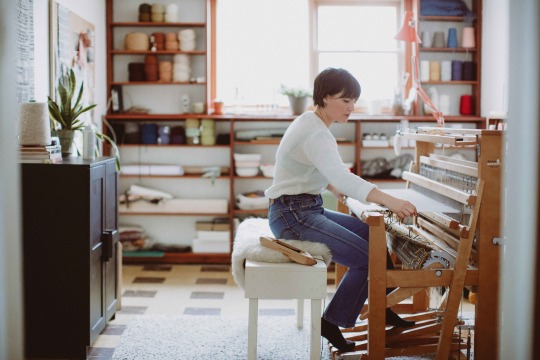
Creative work is work. Just ask Fern Facette, a stalwart advocate for the accessibility of textile arts and the opportunity to make a fair wage teaching them. An enormously talented artist herself, Facette knows first-hand the value of mentorship, opportunity, and community. In fact, they’re three of the reasons she founded Fern’s School of Textile Craft. Committed to putting a modern spin on traditional textiles, Facette and her team offer workshops including weaving, rug hooking, punch needle, sashiko, indigo, eco printing, and much, much more. Just as impressively on offer are all the things Facette knows are vital to community: inclusivity, compassion, and the long-standing tradition of sharing knowledge. This week’s “I Am YEG Arts” story belongs to Fern Facette.
Tell us about your connection to Edmonton and YEG arts.
I moved to Edmonton from LA (Leduc, Alberta ; ) ) during high school. In 2012, I signed up to sell weavings at the Royal Bison Art & Craft Fair, and that’s where I started connecting with Edmonton’s art community. Weaving is a very solitary practice, so it was exciting to be surrounded by other creatives.
What led you to fibre arts? And what was it about the community that made you feel like you belonged?
In high school I signed up for a crochet class and loved that meditative space you enter when deep into a project. That led to knitting, needle work and—eventually—weaving. Honestly, I mostly didn’t feel like I belonged in the fibre community! I was usually surrounded by women who were much older and pretty conservative. Only recently have I felt like I belonged, as the community has grown in size and inclusivity.
What’s the first thing you ever made that inspired your career path?
I couldn’t pin it to one specific object, there were so many! But that first Royal Bison really lit a fire in me. The pressure to fill a table with handmade items is good motivation!


Tell us about how Fern’s School of Craft came to be and what it brings to the YEG arts scene.
People repeatedly asked me if I taught weaving classes, so I decided to give it a try. I rented a small studio space and bought four used looms off Kijiji. Over five years, in true slow DIY Edmonton fashion, we grew to have 20 instructors offering various textile-based workshops. I think what Fern’s brings to the scene is an opportunity to make a fair wage from teaching and the opportunity to dive into an otherwise obscure craft.
What’s one thing you’d like to “un-teach” people about weaving or fabric arts in general?
I’d like people not to think of textiles as just something cute that your grandma does. Yes, that, but also know that making textiles is an ancient art that spans every culture across the planet—that textiles were once the most valuable commodity that shaped history on so many levels.
Tell us about someone who’s been a mentor to you.
I am lucky to have two mentors, Cec Caswell and Kathy Buse. Both have shown great generosity teaching me their respective crafts (rug hooking and weaving). Every craft has small tricks and techniques, they’ve given me so many of these, and I pass them on in every single workshop.

Who’s someone inspiring you right now?
Spray-paint graffiti muralist AJA Louden. He’s doing a tufting artist residency at Fern’s, and it’s been super inspiring to witness. He works hard and has fascinating storylines/themes he’s exploring. He came in not knowing a tonne about tufting, and after a month-and-a-half, the student became the teacher. Also very awesome how community outreach is a big part of his work.
What are you currently working on or hoping to explore next?
Over the past five years my family has been navigating a history of adoption, reunion, and discovery. I hope to work that into my textile practice.
What makes you hopeful these days?
The younger generation is what makes me hopeful these days. I hope they can continue to steer us away from rigid, binary thinking and towards a more compassionate and sustainable future.
You visit Edmonton 20 years from now. What do you hope has changed? What do you hope has stayed the same?
See above answer for what I hope has changed! What I hope has stayed the same is that grit and warmth that Edmontonians exude.
Want more YEG Arts Stories? We’ll be sharing them here all year and on social media using the hashtag #IamYegArts. Follow along! Click here to learn more about Fern Facette, Fern’s School of Textile Craft, upcoming workshops, and much more.
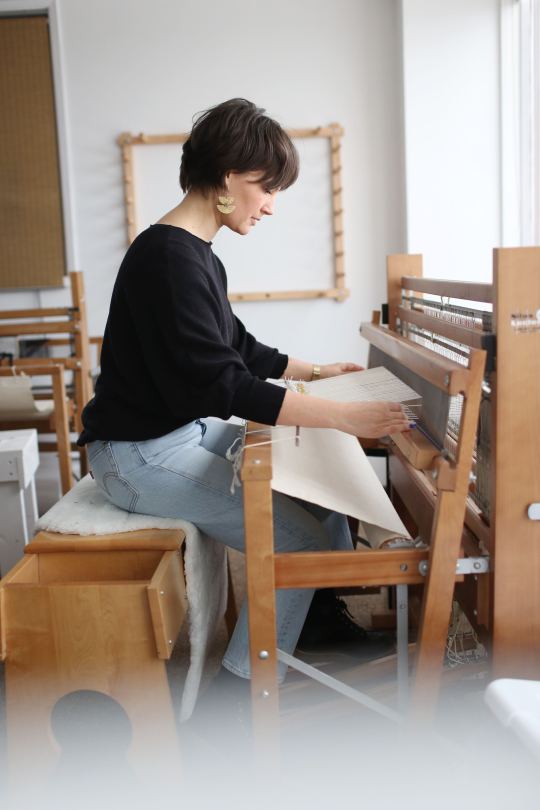
About Fern Facette
Jessica Fern Facette (Fern, she/her) is an Amiskwaciy Waskahikan (Edmonton) based fibre artist who has been weaving for nearly two decades. She is a passionately engaged artist who encourages others to discover textiles. She founded Fern’s School of Textile Craft in 2017, a place where fibre artists from across Canada meet to carry on the long tradition of sharing skills and knowledge. Fern is a stalwart advocate for the accessibility of textile arts and has created many opportunities for folks to explore textiles through years of volunteering, mentoring and—most recently—an in-studio textile residency.
Working within the confines of a four-shaft floor loom, Fern’s own weaving is an exploration of the infinite possibilities of the over/under grid-like woven structure. Boxes and lines of various sizes create repetitive designs, accompanied by use of colour and texture. Natural fibres dictate the objects’ function, from wool cushion to sturdy cotton/linen kitchen towels. Her woven objects are a nod to weavers past and a study on the human relationship to the long-lasting handmade object.
3 notes
·
View notes
Text
Essential Bridal Outfits: For Every Modern Indian Bride To Look Upto - Mora Labels
The wedding lehenga is always the first order of the bridal fashion business, regardless of your style — classic, glamorous, or contemporary. However, saying "yes" to the lehenga is far from the only requirement for a modern bride. A wedding's many events, such as the Engagement party, Mehendi, and Haldi, necessitate distinctive clothing and look. It's enough to make a bride's head spin, but a bridal dress checklist can help you navigate your shopping, whether you're planning a large wedding or a small one.

For Getting Ready: Go Easy with Floral Robes
While some brides begin their wedding day with a meditation, workout, or brunch with their bridal tribe, the getting-ready look is the first official attire. Comfort wear in between the wedding functions, quick runs to parlor, or any other wedding errands is what most bride-to-be’s forget about. A floral or other print robe, pyjama suit, or even chikankari kurti is attractive enough for images yet functional during wedding hair and makeup sessions that photographers love to capture. Specialty accents, such as a touch of feathers on her slippers or some interesting fringe on her robe, can add to the enjoyment.
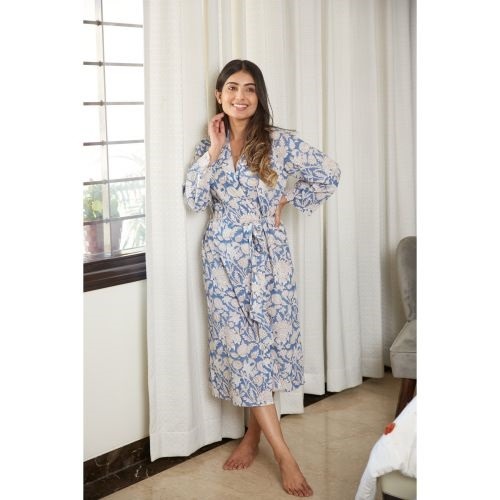

For Pool Parties: Easy Breezy with Off Shoulder Style
Pool parties have become increasingly popular in recent years, as brides and grooms want their guests to engage in the fun before the formal events begin. If you're throwing a pool party, whether it's for sundowners or cocktails soirée, we recommend wearing attire that's inspired by your venue or wedding theme. Is this a destination wedding? When you're at the poolside or by the beach, go for an off-the-shoulder dress or a cowl dress that will look effortless.

For the Mehendi: Amp up with the Jacket Style
A Mehendi, whether casual in a family home or formal at a hotel or restaurant, is often the first event of a wedding extravaganza. Keep it relaxed and informal in a chanderi silk, cotton jacket, or cape set while you revisit the new recollections from the major occasion. We also recommend comfy shoes like flats or jhootis because you know your feet will tear up the dance floor for the engagement party the next day!

For the Engagement Party: Flaunt your flair with A-line Style
The pinnacle of fun of any bridal wardrobe is an engagement party look, which allows brides to show off their flair. Choose a long dress that echoes the aesthetic for brides who already have a definite notion in mind. You can choose the trendiest of all - an A-line dress or an ethnic gown for the engagement party if you have already chosen a traditional lehenga or saree on your wedding day. It establishes the tone of your aesthetic - that stands out differently.

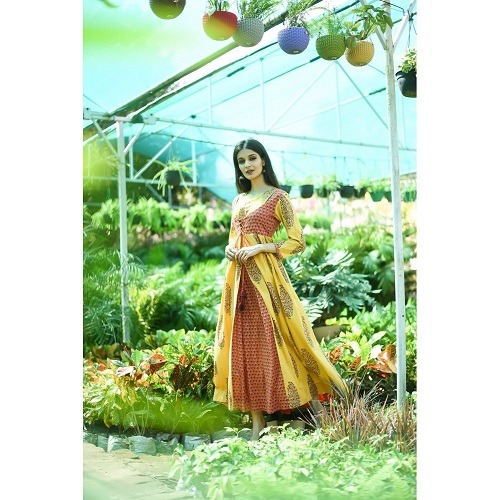
For the Haldi: Twist it with a Dhoti Style
The Haldi dress worn on the wedding day is a popular choice among modern brides. The lehenga may be one of the most comfy Indian outfits but you can prevent seeming too basic in it by adding a cape to it while emphasizing festive elements such as sequins, beading, and shell danglers to the cape. When fully dipped in Haldi, such garments are easy to carry and walk around in.


For the Wedding: Be the Queen in the Lehenga Saree Style
A Lehenga Saree is the most stylish evening dresses! It's completely unique, yet the likelihood of a lehenga Saree has been promoted. It's a beautiful blend of saree pallu with flared lehenga. It is one of the most distinctive Indian Wedding Guest Dresses that you can wear to a wedding or reception. It's also known as a draped lehenga because it doesn't have the traditional flowing skirt shape.
A draped lehenga is pleated or folded in such a way that it becomes compact while maintaining the appearance of formal wear. Draped lehengas are, of course, easy to carry, and they're usually made of lightweight fabrics because it's difficult to drape and sew together heavier or decorated textiles. This summer wedding season, you may simply make a statement appearance by investing in a draped lehenga.

#Women Ethnic Wear#ethnic indian dresses#ethnic kurta sets#evening dresses#chikankari kurti#ethnic wear kurta set#Readymade kurtis online#kurtis online#womens dressing gown#woman kurtis#online indian sarees#kurta of ladies#buy kurtis online
2 notes
·
View notes